How to Grill Killer Kebabs: Tips for Beef, Chicken, & Swordfish
Kebabs pack a punch. They’re quick to make, come from ingredients you probably already have lying around in your kitchen, and should be bursting with flavor. There are many types of meat and vegetables that grill well. Meat and vegetables cut into chunks have plenty of surface area for soaking in flavorful marinades. And the marinades can be as simple or as elaborate as you want them to be—or you can even use your favorite dry rubs.
But most people neglect the few grilling fundamentals that separate truly great kebabs from mere mediocre kebabs. It’s about more than just marinades. Learn the techniques you need for killer kebabs this week.
Common Kebab Cooking Calamities
Here are the most common mistakes people make when grilling kebabs. How many of these are you guilty of?
- Putting different veggies and meats on the same kebab for that “meal on a stick” vibe
- Neglecting to check temperatures, thinking that small chunks should be “eye-ready”
- Stacking the chunks tightly together to fit more on each skewer and thereby abandoning the power of convective currents between the chunks
- Not being careful about cutting meats and vegetables into uniform-sized chunks for uniform cooking
- Using tough meats with too much connective tissue
- Cooking vegetables over direct heat
Well, now is the time to get it right. Keep these foolproof grilling tips in mind next time you make kebabs:
3 Tips for Perfectly Grilled Kebabs
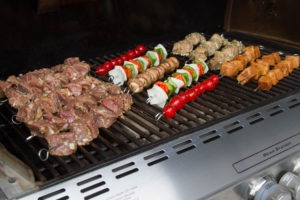
Keep it simple and foolproof, and cook the ingredients separately.
*More tips on grilling skewered vegetables are at the end of this post.
2. Keep the meat or veggies spaced out. If you leave a bit of space between each item on each skewer to ensure even heat circulation all around (see the illustration below), the meat and vegetables will cook more evenly. Alton Brown recommends leaving 1/2″ ( 1-1/4 cm) between the pieces of meat.
Meat that is packed together tightly on a skewer will still cook, but not evenly. The heat from your grill will circulate around the meat as if it’s one piece rather than several (see the illustration below). Because of this, the meat in the center will take longer to cook than the meat on the ends, and those end pieces will be overcooked by the time the center pieces have come to their pull temperature.
Both of the kebab preparations illustrated above will work, just be aware of how they will cook differently.
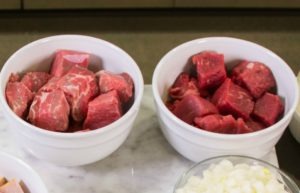
Jeff Savell of Texas A&M University says that the size of the pieces of meat is critical: “If they’re too small they’ll overcook and dry out. If they too large you don’t get the internal temperature right.”
What Types of Meat Work Best?
Beef, lamb, pork, chicken, turkey, swordfish, shrimp, scallops, halibut…there are so many different types of meat that work well!
But grilling involves very high cooking temperatures so the best kebab meats will be:
Tender with very little fat and connective tissue—Small chunks of meat cook very quickly on the grill. There won’t be nearly enough time for fat to render and connective tissue to properly dissolve. Meat that is tough often becomes fairly rubbery when cooked quickly on a skewer.
Avoid tough meats like brisket or pork shoulder. And trim away the chunks of fat, gristle, or connective tissue you do see before cutting the tender meat into cubes.
4 Keys to Great Marinades
Marinating meat seasons and tenderizes it, which is especially helpful for cuts of meat that are slightly tough, very lean, or otherwise low on flavor. Kenji points out 4 important components to great marinades in his book, The Food Lab.
- Oil: Oil makes the marinade thicker and tackier, helping it stick to the meat better. It is a vehicle to flavor the meat since some aromatics such as garlic and some spices are oil soluble. A thin coating of oil helps heat to transfer more evenly as the meat cooks, and it also helps keep the meat from sticking to the grill.
- Salt: When salt is dissolved in liquid it dissolves the myosin in protein fibers, making the meat a bit looser and able to retain its own moisture better. Salt also penetrates into the meat, seasoning it.
- Fruits rich in proteases: Proteases are enzymes that break down protein in muscle fibers and connective tissue. Naturally-occurring proteases can be found in pineapples, mangoes, papayas, and ginger.
- Acid: Acids in marinades help to break down connective tissue, slightly tenderizing the final product. Acids can also denature the protein in muscle fibers, chemically “cooking” it. If the ratio of acid in the marinade is too high, the meat can become opaque and chalky. Keep your acid to oil ratio at 1:1 or lower.
Aromatics: Aromatics are ingredients that only flavor the exterior of the meat. Garlic, onions, shallots, herbs, and spices can all be powerful flavor components, especially when combined with oil.
Aromatics are not considered an essential component in marinades since their effect is merely superficial, rather than improving the texture and cooking process like the other 4 ingredients do.
Note: When Recycling Is NOT OK
Used marinade is contaminated with raw meat juice and is therefore unsafe to consume. Even boiling might not make it safe. If you want a sauce to serve with cooked meat, make a little extra marinade and set it aside before adding the rest to the raw meat. —Master of the Grill, America’s Test Kitchen
Marinating Times and Pull Temperatures
How long to marinate the meat depends on the type of meat you’ll be grilling. Fish is far more delicate than red meat and needs far less time in a marinade. Here is a guide to how long some meats need to marinade, and their pull temperatures.
Note that these pull temperatures are slightly higher than they would be for grilling steaks or other whole muscle cuts. This is because kebabs have small chunks of meat that will experience little to no carryover cooking after being removed from the grill.
➤ Equipment: Skewers
The Debate of Stainless Steel vs Wood
Soaking: Stainless steel skewers are great because they’re durable and don’t need to soak in water before grilling, and you never have to worry about splinters. If you’re using wood skewers, you’ll need to be sure and soak them for 2 hours prior to grilling to keep them from burning.
Cleanup: Wood skewers have the advantage of being disposable. Just chuck them along with anything else that goes in the trash. Metal skewers are reusable, but they do give you something else to wash. The choice is up to you. We went with reusable, no-need-for-soaking stainless steel skewers.
How Long Will the Kebabs Take To Grill?
The length of cooking time depends on a few factors…
- the temperature of your grill and how well it’s maintained throughout the cook
- the size of the cubed meat
- and your desired doneness temperature
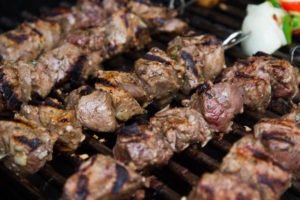
Kebab Recipes
We made three different kebabs: beef, chicken, and swordfish, and each with a different marinade.
Beef Kebabs—From Master of the Grill, by America’s Test Kitchen
- 2 lbs. steak tips, cut into 1-1/2″ to 2″ cubes
Marinade
- 1 onion, chopped
- 1/3 cup beef broth
- 1/3 cup vegetable oil
- 3 tablespoons tomato paste (or tomato sauce)
- 6 garlic cloves, minced
- 2 tbsp fresh chopped rosemary
- 2 teaspoons finely grated lemon zest
- 1-1/2 tsp sugar
- 2 tsp salt
- 3/4 tsp pepper
Instructions
- Stir together all marinade ingredients to thoroughly combine.
- Place cubed meat into a gallon-size zipper-lock bag. Pour the marinade over the meat and mix well to coat all pieces of meat, force all the air out of the bag and seal it shut.
- Put the meat into a container and place in the refrigerator on the bottom shelf to marinade for 3-24 hours. Flip the bag over once or twice for even marinating.
- Fire up your grill and allow it to preheat while you prepare the kebabs.
- After marinating, thread the meat onto skewers leaving about 1/2″ space between each piece of meat.
- Clean and oil your grill grate, and place the prepared skewers onto the grill over high heat. Flip the skewers every 3-4 minutes, until they reach about 125-130°F (52-54°C).
- Spot-check every piece of meat on each skewer with an instant-read thermometer like a Thermapen. Once the skewers’ internal pull temperature has been verified, remove from the grill and tent with foil while they rest for about 10-15 minutes.
Chicken Kebabs—From Master of the Grill, by America’s Test Kitchen
- 1-1/2 lbs. chicken breast, cut into 1-1/2″ to 2″ cubes
Marinade
- 1/2 cup olive oil
- 6 garlic cloves, minced
- 1/4 cup chopped fresh chives, minced fresh basil, parsley, tarragon, oregano, cilantro, or mint; or 2 tbsp minced fresh thyme or rosemary
- 1 tsp salt
- 1 tsp salt
- Pepper to taste
Instructions
- Whisk together all marinade ingredients.
- Place chicken cubes into a gallon-size zipper-lock bag and mix well to coat the chicken evenly with the marinade.
- Seal the bag, place in a container, and refrigerate on the bottom shelf of your refrigerator for 3-24 hours; turning once or twice for even marinating.
- Fire up your grill and allow it to preheat while you prepare the kebabs.
- Remove the chicken from the marinade and thread onto skewers leaving 1/2″ of space between each cube.
- Clean and oil your grill’s grate and place the chicken kebabs on the grill leaving about 2″ between each kebab. Turn every 3-4 minutes.
- After about 10 minutes start spot-checking your kebabs for doneness with a Thermapen. Once each piece of chicken has reached 155-160°F (68-71°C), remove them from the grill and tent with foil. Rest the kebabs for 10-15 minutes.
Swordfish Kebabs
- 1-1/2 lbs. skinless swordfish steak, cut into 1-1/2″ to 2″ cubes
Dry Rub
- 3 tbsp ground cumin
- 2 tbsp salt
- 1 Tbsp paprika
- 1 tsp pepper
Instructions
- Whisk or toss together the dry rub ingredients and mix thoroughly.
- Place the swordfish cubes into a gallon-size zipper-lock bag and sprinkle with enough of the rub to coat each piece evenly. Zip the bag shut (with plenty of air) and shake the bag to coat the meat evenly.
- Open the bag, remove the air and seal the bag. Place the bag into a container and refrigerate for 15-30 minutes.
- Fire up your grill and allow it to preheat while you prepare the swordfish kebabs.
- Remove the swordfish from the refrigerator and thread the fish onto skewers leaving about 1/2″ of space between each cube.
- Clean and oil your grill grate. Place the swordfish skewers on the grill about 2″ apart. Turn the kebabs about every 3-4 minutes.
- Fish skewers will cook faster than chicken or beef. Start checking the internal temperature of each piece with a Thermapen after about 10 minutes of cooking. Once the internal temperature of each piece reaches 130°F (54°C), remove the kebabs from the grill. Transfer them to a platter or cutting board, tent with foil and rest the kebabs for 5-10 minutes.
Special Tips for Grilling Vegetable Kebabs
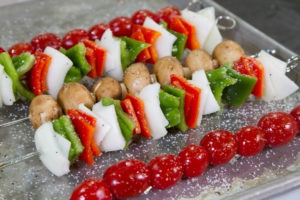
Keep Them Separated: Like items that cook at the same rate can be grilled on the same skewer, such as onions and bell peppers. But veggies like tomatoes and mushrooms cook faster and should not be combined together.
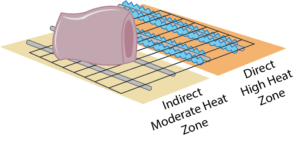
These tips apply to any type of kebab, so use them with any skewered meat recipe you come across. And get creative with your marinades! Grilling kebabs may turn into one of your favorite hobbies throughout the grilling season.
Products Used:
Resources:
5 Keys to Making the Best Grilled Skewers of Summer, Anna Stockwell, epicurious.com






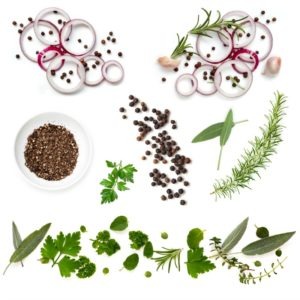

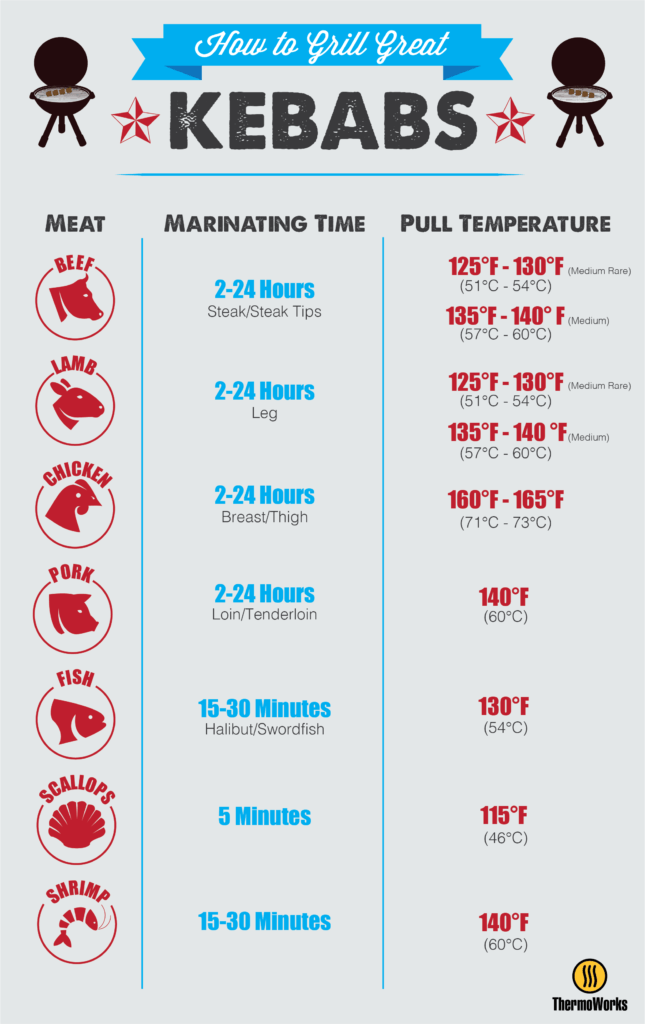



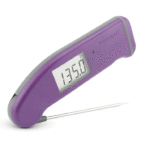
This is one of the most informative guides I have ever seen. Thank you.
Robert,
Thank you!
Happy Cooking
-Kim
Great post!
Thanks, Elisha!
Excellent tips—thank you! My husband had almost sworn off kebabs, but was guilty of all 6 of the calamities. I’m looking forward to sunny weather, great kebabs, and a happy grill master!
Anna,
Hopefully this post will get your husband to grill kebabs with confidence. Bring on the sunny weather!
Thanks,
-Kim
As an avid live-fire cook I have to point out a glaring omission to the ‘Common Kebab Cooking Calamities’ list of things not to do here, and here it is: ALWAYS use either a wide, single flat skewer or TWO rod-type skewers for each set when grilling kebabs. Not doing so will guarantee that your kebabs will rotate when you try to turn them resulting in uneven cooking and a frustrating experience. It takes more time to double-skewer but the end result will be worth the effort.
Mark,
Thank you—yes! Using two skewers is a fantastic tip to keep the food on your kebabs from rotating.
Thanks again!
-Kim
This was a great article-just like all of the others you have published. I use flattened stainless steel skewers or double threaded bamboo ones whenever possible to make turning food on the grill easier. Please keep your articles (and your products!) coming.
Many thanks
Bill,
So glad our content is helpful for you!
Thanks,
-Kim
“When Recycling Is NOT OK
“Used marinade is contaminated with raw meat juice and is therefore unsafe to consume. Even boiling might not make it safe. If you want a sauce to serve with cooked meat, make a little extra marinade and set it aside before adding the rest to the raw meat. —Master of the Grill, America’s Test Kitchen”
The first two sentences not only SOUND ridiculous, they ARE ridiculous. What this is saying is that beef that is cooked to the pull temperature “beef should be pulled at about 125-130°F” is safe to eat at that temperature but that liquid that has been in contact with this beef is not safe even at 212°F, over 80°F higher!
Totally ridiculous statements!!!
If the meat is safe to eat at such a low temperature, any liquid from the meat which has been heated to boiling for several minutes is even safer, as long as the liquid hasn’t been allowed to sit at room temperature any longer than the meat has.
The interior of meat is, generally, sterile. Bacteria live on the surfaces and get spread around during slaughter, butchering, etc. When we marinate meat, we’re creating high-contact with the surfaces, and the marinade is often quite nutritious to bacteria. Cooking the meat kills the bacteria on the surface, because they experience much higher temps than the inside of the meat. To then take the marinade that has had raw meat soaking in it for hours and pour it on our (now food-safe) surfaces is not wise.
Bringing it up to a boil will kill anything living in it. Then it can be applied, and it will be hot, which is nice anyhow.
EXCELLENT INFORMATION!
I have purchased 4 instant read Thermapens for my family and recommended them to my friends and I wouldn’t enjoy cooking as much as I do without them , My friends that did buy them have said they wouldn’t be without them ether . They inturn have recommended to their friends. I also have several other pouts of ThermoWorks. If it wasn’t for Cooks Illustrated I probably would have not been aware of your company. Needless to say I have a ” investment” in their cookbooks and products they have recommended.
I never was interested in cooking until about 3 years ago now I split my time between cooking and wood working
Bob,
Thank you so much for the kind words!
Happy Grilling,
-Kim
This is a really helpful and highly detailed article. Thanks so much!
Christina,
So glad you liked the article!
Thanks,
-Kim
Fantastic article. A game changer that has put kabobs on a regular rotation at my house.
I have to ask if the swordfish recipe is correct. I made them and the cumin was WAY overpowering. Perhaps its supposed to be 3 teaspoons instead of tablespoons?
Shawn,
Glad the article was helpful for you! The swordfish rub recipe is written how we used it. If you find the cumin overpowering, definitely take the amount down the next time you use it.
Thanks,
-Kim
Why wait for sunny weather for the kabobs, any time is a good time.
Bob.
Bob,
Agreed! Anytime is the perfect time to fire up your grill.
-Kim
Double skewering is even better when one uses a double metal skewer available from several companies, e.g. Weber. They are very stable and I use them for many types of meat- easy to turn, just grab a center piece of meat with tongs and turn…no rotation and wobbling like with 2 separate skewers. Also easier to skewer many types of veggies with 2 thin skewers rather than one larger one, which on occasion fractures the veggie.
Jim,
Great tips. Thanks!
-Kim
I am saving this article in ‘favorites’! Thank you.
Any special tips on keeping onions, peppers, mushrooms, from splitting when you put the skewer in? Should I get out my drill and make a pilot hole?
Thanks, Sharon!
My only thoughts on not splitting your veg when kebabing would be:
Hope that helps!
Tim
Thanks, Tim!
This is probably the best and thorough information I’ve ever seen……and I grill quite a bit. Thank you!!!!!!
This blog post exceeded all of my expectations, and then some! I learned so much more than I was looking for and I’m so grateful I read through. Definitely bookmarking it for future reference. Thank you!!
Thanks for the comment, and happy cooking!